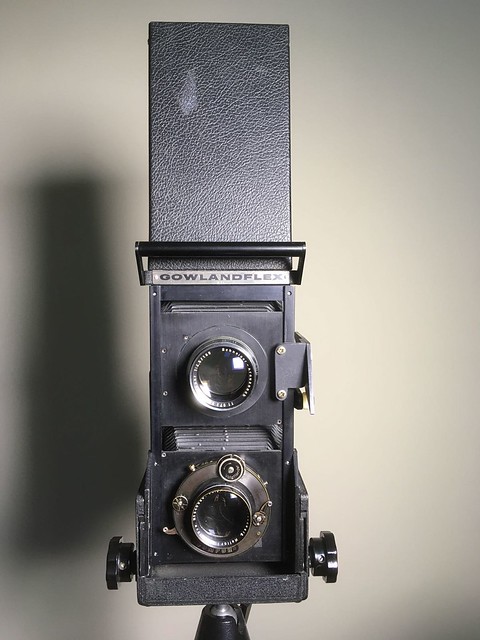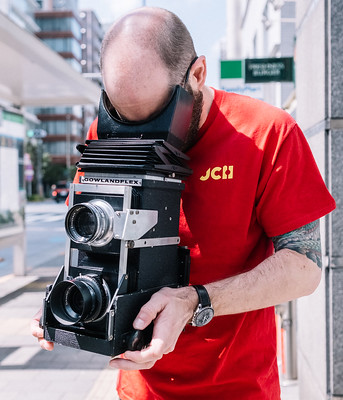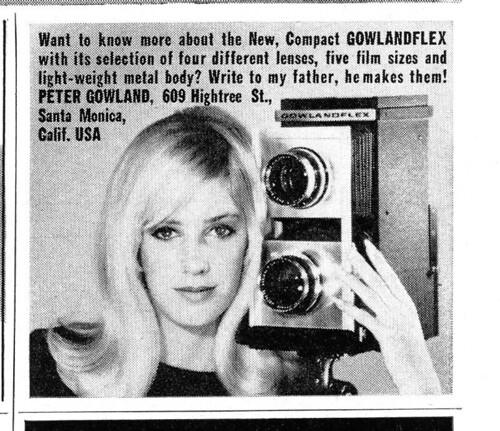Difference between revisions of "Gowlandflex"
m (+cats) |
m (clearer footnote) |
||
| Line 12: | Line 12: | ||
For magazine-cover and pinup work, a negative of 4x5 inches was considered standard (as retouching often was done directly on the film). But having originally used a [[Rolleiflex]], Gowland wanted to preserve the mobility and continuous viewing of 6x6cm twin-lens cameras, as he often worked outdoors and on beaches in California's mild weather.<ref>Typical of this style is one [https://www.flickr.com/photos/vox/52391061316/in/pool-camerawiki/ July, 1948, ''Popular Photography'' cover] by Gowland of a favorite model, Pat Hall.</ref> Thus the Gowlandflex was constructed—evidently in Gowland's own home workshop—in lightweight aluminum and at 8 pounds<ref>A point mentioned in an [https://www.latimes.com/archives/la-xpm-2004-apr-13-et-pool13-story.html 2004 ''LA Times'' profile] of the then 88, still-active Gowland.</ref> can conceivably be handheld.<ref>Photographer Philippe Halsman had worked with [[Fairchild]] to create prototype 4x5 Fairchild-Halsman TLRs; but [https://www.life.com/photographer/philippe-halsman/ available images] suggest they were likely quite heavy.</ref> | For magazine-cover and pinup work, a negative of 4x5 inches was considered standard (as retouching often was done directly on the film). But having originally used a [[Rolleiflex]], Gowland wanted to preserve the mobility and continuous viewing of 6x6cm twin-lens cameras, as he often worked outdoors and on beaches in California's mild weather.<ref>Typical of this style is one [https://www.flickr.com/photos/vox/52391061316/in/pool-camerawiki/ July, 1948, ''Popular Photography'' cover] by Gowland of a favorite model, Pat Hall.</ref> Thus the Gowlandflex was constructed—evidently in Gowland's own home workshop—in lightweight aluminum and at 8 pounds<ref>A point mentioned in an [https://www.latimes.com/archives/la-xpm-2004-apr-13-et-pool13-story.html 2004 ''LA Times'' profile] of the then 88, still-active Gowland.</ref> can conceivably be handheld.<ref>Photographer Philippe Halsman had worked with [[Fairchild]] to create prototype 4x5 Fairchild-Halsman TLRs; but [https://www.life.com/photographer/philippe-halsman/ available images] suggest they were likely quite heavy.</ref> | ||
| − | The large spacing between viewing and taking lens inevitably leads to significant [[parallax]] error, but later<ref> A 1968 [https://www.flickr.com/photos/camerawiki/52670018082/in/pool-camerawiki visit from ''Popular Photography'''s Norman Rothschild] indicated this was then still a new feature (Vol. 63, No. 5; pages 132-133).</ref> Gowlandflex models raise and lower the viewing lensboard using a simple ramp-shaped cam, to correct the viewing frame while focusing. This was one of several refinements over what was said to be 30 years of small improvements.<ref name="PG.COM"> | + | The large spacing between viewing and taking lens inevitably leads to significant [[parallax]] error, but later<ref> A 1968 [https://www.flickr.com/photos/camerawiki/52670018082/in/pool-camerawiki visit from ''Popular Photography'''s Norman Rothschild] indicated this was then still a new feature (Vol. 63, No. 5; pages 132-133).</ref> Gowlandflex models raise and lower the viewing lensboard using a simple ramp-shaped cam, to correct the viewing frame while focusing. This was one of several refinements over what was said to be 30 years of small improvements.<ref name="PG.COM">These details are from the [https://www.petergowland.com/gowlandflex-cameras Cameras Page] of the [https://www.petergowland.com/ Alice & Peter Gowland Photography] site, although no cameras are currently available.</ref> |
Two variants of the Gowlandflex include an immense 8x10 version, of which only seven were actually sold<ref name="PG.COM"/>, and the '''Wide Angle Gowlandflex''' (which is twin-lensed but lacks an actual reflex mirror).<ref> A camera of this design [http://www.tlr-cameras.com/misc/Gowlandflex.htm appears at] Barry Toogood's [http://www.tlr-cameras.com/index.htm TLR-Cameras.com]</ref> | Two variants of the Gowlandflex include an immense 8x10 version, of which only seven were actually sold<ref name="PG.COM"/>, and the '''Wide Angle Gowlandflex''' (which is twin-lensed but lacks an actual reflex mirror).<ref> A camera of this design [http://www.tlr-cameras.com/misc/Gowlandflex.htm appears at] Barry Toogood's [http://www.tlr-cameras.com/index.htm TLR-Cameras.com]</ref> | ||
Revision as of 13:37, 31 March 2023

|
| 4x5-inch Gowlandflex image by Nasir Hamid (Image rights) |
California glamour and celebrity photographer Peter Gowland (1916-2010) was also very active as a camera tinkerer and inventor throughout his career, addressing the unusual needs of his own and other photographers' work. He claimed he had invented 30 cameras,[1] which included aerial models and lightweight view cameras.[2] But he is certainly best known for the Gowlandflex large-format TLR, and in particular the Gowlandflex 4x5 Glamour Camera.
For magazine-cover and pinup work, a negative of 4x5 inches was considered standard (as retouching often was done directly on the film). But having originally used a Rolleiflex, Gowland wanted to preserve the mobility and continuous viewing of 6x6cm twin-lens cameras, as he often worked outdoors and on beaches in California's mild weather.[3] Thus the Gowlandflex was constructed—evidently in Gowland's own home workshop—in lightweight aluminum and at 8 pounds[4] can conceivably be handheld.[5]
The large spacing between viewing and taking lens inevitably leads to significant parallax error, but later[6] Gowlandflex models raise and lower the viewing lensboard using a simple ramp-shaped cam, to correct the viewing frame while focusing. This was one of several refinements over what was said to be 30 years of small improvements.[7]
Two variants of the Gowlandflex include an immense 8x10 version, of which only seven were actually sold[7], and the Wide Angle Gowlandflex (which is twin-lensed but lacks an actual reflex mirror).[8]
Between all of his designs Gowland claimed to have sold 1,500 cameras[9] with 600 of these being the most-popular model the 4x5 TLR.[1]
Notes
- ↑ 1.0 1.1 See an archived page about his cameras from the still-active Alice & Peter Gowland Photography.
- ↑ Only 21 of these models were sold to others, according to the 2023 "about" page at PeterGowland.com.
- ↑ Typical of this style is one July, 1948, Popular Photography cover by Gowland of a favorite model, Pat Hall.
- ↑ A point mentioned in an 2004 LA Times profile of the then 88, still-active Gowland.
- ↑ Photographer Philippe Halsman had worked with Fairchild to create prototype 4x5 Fairchild-Halsman TLRs; but available images suggest they were likely quite heavy.
- ↑ A 1968 visit from Popular Photography's Norman Rothschild indicated this was then still a new feature (Vol. 63, No. 5; pages 132-133).
- ↑ 7.0 7.1 These details are from the Cameras Page of the Alice & Peter Gowland Photography site, although no cameras are currently available.
- ↑ A camera of this design appears at Barry Toogood's TLR-Cameras.com
- ↑ Stated in his 2010 obituary in the LA Times.
Links
- Sketch of Peter & Alice Gowland's career at PeterGowland.com
- New York Times obituary of Peter Gowland
- Gowlandflex pictured with accessories, 5x7 adapters and viewing hoods, from S. Katz on Flickr

|
| Hand-holdable? image by Japan Camera Hunter (Image rights) |

|
| 1966 advertising |